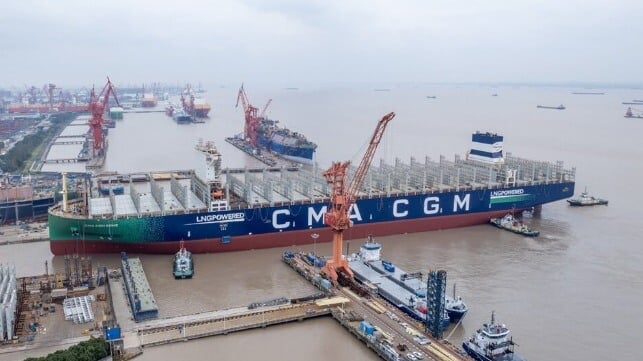Big Gets Bigger as Largest Container Carriers Continue Growth

The largest container carriers are continuing their capacity growth, although at a slower pace so far in 2025, according to a new report from Alphaliner. It points out that while MSC Mediterranean Shipping Company continues to pull away from the pack, other carriers are also accelerating growth, and for the first time, CMA CGM topped the 4 million TEU capacity mark.
In the first half of 2025, Alphaliner reports saw an additional 1.18 million TEU of capacity added to the global fleet. They note it was less than four percent, which marks a break from recent growth-fueled years, but the orderbook remains strong. The sector reached a total global capacity of 32.7 million TEU with 7,336 active vessels representing a combined total of 388 million dwt, Alphaliner calculates.
The report highlights that nine of the top ten carriers each added capacity in the first half of 2025, with an average increase of approximately four percent in capacity. Only Zim, which is challenged by regional geopolitical issues reduced its capacity since the start of the year.
MSC’s growth is predictable, but it accounted for nearly a third (31 percent) of the growth in the sector. It continues to move away from the pack with a total capacity of 6.6 million TEU. By comparison, Maersk remains at 4.6 million TEU while CMA CGM topped the 4 million mark for the first time.
“MSC's fleet has expanded by 365,173 TEU since the start of the year,” highlights Alphaliner. “This growth stems from newbuilding deliveries and ongoing second-hand tonnage acquisition. So far in 2025, MSC has received 25 newbuildings (316,691 TEU), including 12 'Neo-panamax' vessels (15,400– 16,200 TEU), bolstering its standalone network. This consistent expansion is not new for the Geneva-based carrier - MSC has been the strongest growing carrier for several years running, with notable increases of 12.3 percent (2024), 22.0 percent (2023), 7.5 percent (2022), and 10.7 percent (2021).”
The fastest growing carrier, however, was Ocean Network Express (ONE), which added nearly six percent to its capacity. “This year marks a strategic shift for ONE, as it began taking delivery of new capacity under direct ownership,” notes Alphaliner.
CMA CGM added four percent to its capacity this year as it executes a growth strategy. Alphaliner highlights that as of the beginning of July, the French carrier reached a capacity of 4 million TEU. It has a fleet of 683 owned or chartered containerships. Alphaliner calculates CMA CGM has quadrupled its since in the last 16 years. It reached 1 million TEU in 2009 after the large acquisitions of ANL, American President Lines, and U.S. Lines, as well as smaller regional carriers.
Faced with political issues and Donald Trump’s tariffs, the sector near term is facing uncertainty. Xeneta, in its weekly update notes, continues declines in freight rates, highlighting for example, that in the Transpacific trade, “carriers are now deploying more capacity above the level required to meet shippers’ demand.” It notes, however, that “more ‘severe’ overcapacity was seen into the U.S. East Coast in the early days of July.”
Despite these concerns, carriers are continuing their growth plans. MSC has the largest orderbook, reports Alphaliner with a “whopping 135 vessels on order for a total of 2.2 million TEU.”
CMA CGM, however, is the one to watch. Alphaliner reports it has 95 vessels on order, which represents 1.5 million TEU. The French carrier is less than 600,000 TEU behind Maersk. With the Danish company having said it plans to keep its capacity stable, CMA CGM continues to be on track to surpass Maersk for the number two position in the industry.
